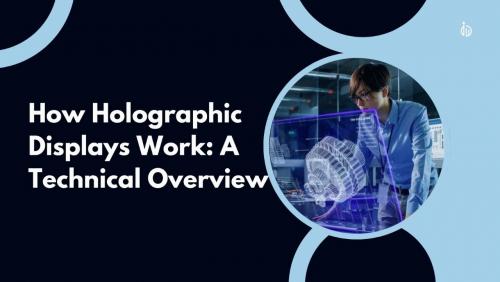How Holographic Displays Work - A Technical Overview.

Holographic displays are new in technology, creating the illusion of a three-dimensional picture floating in space. While traditional 3D displays require special glasses or headsets to view the image, holographic displays give viewers a way to see the image without any equipment. This is sure to revolutionize many industries, from entertainment and advertisement to education and telecommunication sectors. In the present article, we talk about some of the technical principles that underlie 3D holographic displays and how they engineered the illusion of floating images, mesmerizingly.
The Science Behind Hologram Displays
A holographic display, as mentioned above, depends on two prevalent technologies to operate: a light field display and a spatial light modulator.
Light field displays change one major thing: unlike earlier screens, they retain all the light rays in a scene and project them more truthfully. They accomplish this task by capturing the intensity, colour, and direction of the light rays and reproducing them to imitate how light would generally travel in the real world.
Spatial light modulators, on the other hand, modulate both the phase and amplitude of light waves to reconstruct the holographic image. SLMs may be easily described as programmable diffraction gratings capable of affecting the wavefront of light to achieve full control over the direction and intensity of the light rays.
By integrating these two technologies, holographic displays can project an image seemingly three-dimensional and hovering in space.
Role of Coherent Light
The 3D hologram display also uses coherent light, usually from a laser source. It is a single-wavelength light having constant phase differences between its waves, which are the two characteristics that facilitate the construction of interference patterns.
The coherent light obtained from a laser is divided into two beams: one will illuminate the object to be recorded, and the other will act as a reference beam. The interference pattern between these two beams then gets recorded on a photosensitive material - holographic film or digital sensor.
This interference pattern contains all of the information that is needed to recreate the wavefront of the light reflected from the object, including its intensity, colour, and direction. After a hologram has been illuminated with that reference beam, it reconstructs the wavefront original to it, thereby producing the illusion of a three-dimensional image.
The Role of Digital Technology
While holograms were recorded on photographic film earlier, the modern holographic display is digitally enabled so that the images are captured and displayed using digital technology.
Digital holographic displays make use of spatial light modulators like liquid crystal on silicon (LCoS) or digital micromirror devices (DMDs) to modulate the phase and amplitude of the light waves. The computer controls the modulators under the influence of the data coming from the holographic imaging being generated, which is then displayed over the SLM.
Several advantages of using digital technology are involved in holographic recording by traditional methodology.
Flexibility - Digital holograms can easily be modified, manipulated, and updated without a physical change to the recording medium.
Resolution - Digital SLMs can have very high resolution, which enables the creation of detailed and realistic holographic images.
Real-Time Generation - Digital 3D holographic displays can generate and update the holographic image in real time, thus enabling interactive applications and dynamic content.
Challenges and Further Developments
Though holographic displays have advanced much in the recent past, several challenges must be overcome before they can become mainstream.
One of the major challenges associated with hologram displays is that the generation and recreation of holographic images in real time require high computational power. So, one needs huge amounts of data to represent a high-quality hologram, which current computing technology has to struggle with.
Another challenge is the small field of view and holographic display viewing angle. Most existing systems today have a rather limited viewing angle, which makes their applicability substantially limited in some cases.
Though there exist challenges, researchers and companies are trying all means to overcome them so that holographic technology is widely spread among people. Some exciting developments in this respect include.
SLM Technology Advancements - New SLM-type developments are underway for making holographic displays more effective and efficient, such as FLCoS and Organic Light-Emitting Diode SLMs.
Improved Computational Algorithms - New algorithms and techniques for reducing the computational burden in generating holographic images are being developed, using machine learning and artificial intelligence.
Multiview and Light Field Displays - Within alternative approaches being investigated relative to holographic displays by certain researchers are multiview and light field displays that provide a greater field of view and more natural depth signalling.
Conclusion
3D Holographic displays are just an intriguing area of fast-developing technology that holds the potential to eventually replace traditional screens as we know them today. Since holographic display technology projects images in space, seemingly three-dimensional, it opens up much more possibilities for an immersive and interactive user experience than any traditional 2D or even stereoscopic 3D display. To know more about holographic displays, get in touch with Vision3D customer care number - +91-8971953451.
Post Your Ad Here
Comments